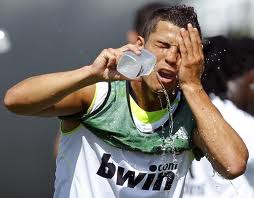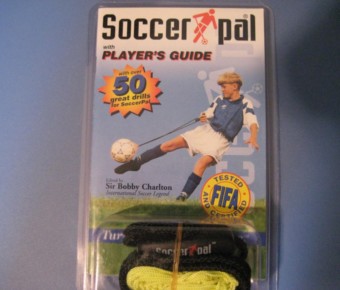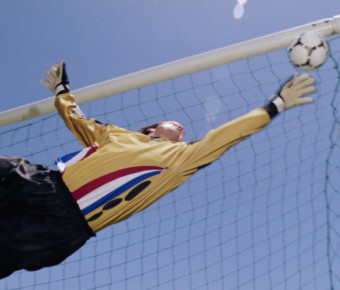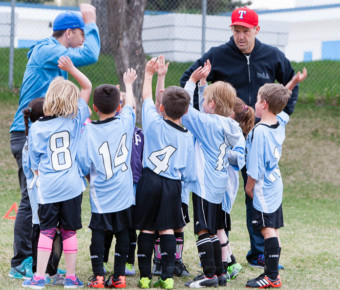“Go and get a drink!”

I coach 7 years old to adults and I like to keep the intensity high. I watch my players as they train and I like to make sure that they are pushing themselves and not just “going through the motions”.
At the end of a segment of the coaching session, after I have given the players some feedback on their activity, I usually shout “go and get a drink”. Too often I hear from some of the players, “I don’t need a drink!”
When I hear these words, to me it says “I do not want to play at my peak and I am happy with mediocrity!”
I think half of my players (of all ages) think this is just a time for me to put out some more cones and set up something new for them to play.
Well now I’m going to set the record straight courtesy of information from Peak Performance and “sports medicine” on About.com
I’ll do the technical stuff later, but this is basic need to know.
When we perform in a game we want to perform at the highest level, when we train, we should try to do so at the highest level also. If our performance drops, we are not going to improve at the highest possible level.
Even low levels of dehydration have physiological consequences. A loss of 2% body weight (just 1kg for a 50kg person) causes an increase in perceived effort and is claimed to reduce performance by 10-20% A fluid loss exceeding 3-5% body weight reduces aerobic exercise performance noticeably and impairs reaction time, judgement, concentration and decision making. All things, I think we can agree, are required of us as players at our peak.
The Rules of Fluid Intake according to Peak Performance :
RULE NO. 1: The rate of passage of water from your stomach into your small intestine depends on HOW MUCH fluid is actually in your stomach. If there’s lots of water there, fluid flow from stomach to intestine is like a springtime flood; if there’s little water, the movement resembles a lightly dripping tap. Therefore, to increase stomach-intestinal flow (and overall absorption of water) you need to deposit a fair amount of liquid in your stomach just before you begin your exercise. In fact, 10-12 ounces of fluid is a good start. This will feel uncomfortable at first, so practise funnelling this amount of beverage into your ‘tank’ several times before an actual competition.
RULE NO. 2: To sustain a rapid movement of fluid into your small intestine during your exertions, take three to four sips of beverage every 10 minutes if possible, or five to six swallows every 15 minutes.
RULE NO. 3: If you’re going to be exercising for less than 60 minutes, don’t worry about including carbohydrate in your drink; plain water is fine. For more prolonged efforts, however, you will want the carbohydrate.
RULE NO. 4: Years of research have suggested that the correct concentration of carbohydrate in your drink is about 5-7 per cent. Most commercial sports drinks fall within this range, and you can make your own 6-per cent drink by mixing five tablespoons of table sugar with each litre of water that you use. A bit of sodium boosts absorption; one-third teaspoon of salt per litre of water is about right. Although 5-7 per cent carbohydrate solutions seem to work best for most individuals, there is evidence that some endurance athletes can fare better with higher concentrations. In research carried out recently at Liverpool John Moores University, for example, cyclists who ingested a 15-per cent maltodextrin solution improved their endurance by 30 per cent compared to individuals who used a 5-percent glucose drink. The 15-per cent drink also drained from the stomach as quickly as the 5-per cent one, though many other studies have linked such concentrated drinks with a slowdown in water movement.
RULE NO. 5: A 6- per cent ‘simple sugar’ drink will empty from your stomach at about the same rate as a fancy, 6-per cent ‘glucose polymer’ beverage, so don’t fall for the idea that the latter can boost water absorption or enhance your performance more than the former, and don’t pay more for the glucose-polymer concoction.
RULE NO 6: Contrary to what you’ve heard, cold drinks aren’t absorbed into your body more quickly than warm ones. However, cold drinks are often more palatable than warm ones during exercise, so if coldness helps you to drink large quantities of fluid while you exert yourself, then keep your drinks cool.
RULE NO. 7: Swilling drinks during exercise does NOT increase your risk of digestive-system problems. In actuality, most gut disorders that arise during exercise are caused by dehydration, not from taking in fluid. Dehydration induces nausea and discomfort by reducing blood flow to the digestive system, so by all means keep drinking!
So what is actually happening to us ?
Exercise produces heat. Prevention of overheating occurs by transfer of heat to the skin by vasodilation of the cutaneous circulation, and by the cooling effect of evaporation of sweat.
Although sweat rates are highest under conditions of high-intensity exercise in heat and high humidity, total fluid losses can be appreciable in very prolonged events, whatever the conditions. Unless fluid losses are replaced by drinks, sweating causes progressive depletion of circulating blood volume, leading to hypohydration (commonly called dehydration) and a thickening of blood. This places a strain on the cardiovascular system, with a rise in heart rate in order to maintain adequate blood flow to exercising muscles and vital organs. As blood volume depletes, blood flow to the skin is reduced. As a result, sweating decreases and heat dissipation from the skin is impaired, causing body core temperature to rise, potentially leading to heat stress, collapse and even death.
So now you know!
“GO AND GET A DRINK!”









